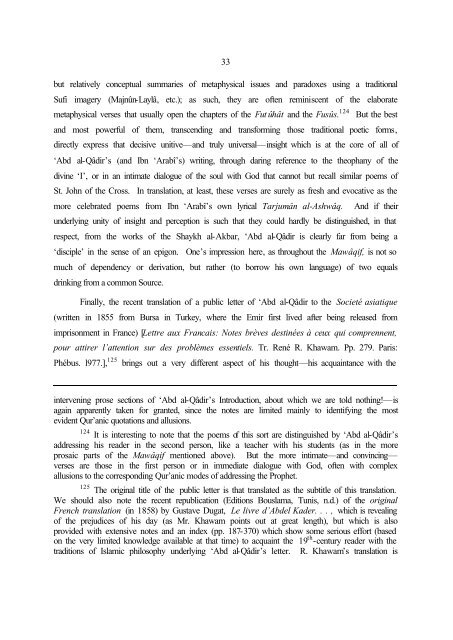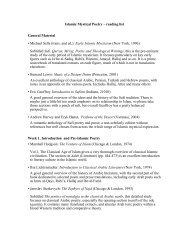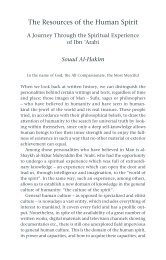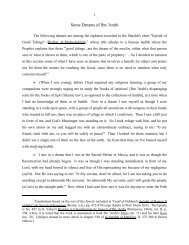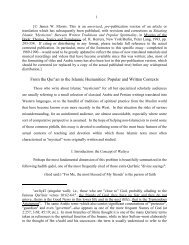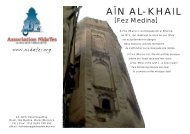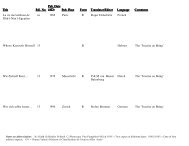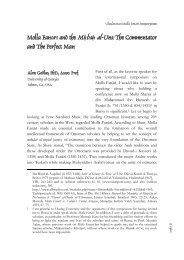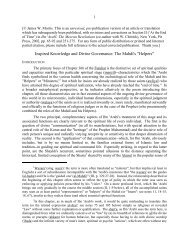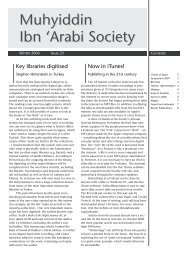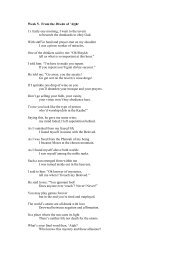Part III (pdf) - Muhyiddin Ibn Arabi Society
Part III (pdf) - Muhyiddin Ibn Arabi Society
Part III (pdf) - Muhyiddin Ibn Arabi Society
Create successful ePaper yourself
Turn your PDF publications into a flip-book with our unique Google optimized e-Paper software.
33but relatively conceptual summaries of metaphysical issues and paradoxes using a traditionalSufi imagery (Majnûn-Laylâ, etc.); as such, they are often reminiscent of the elaboratemetaphysical verses that usually open the chapters of the Fut ûhât and the Fusûs. 124 But the bestand most powerful of them, transcending and transforming those traditional poetic forms,directly express that decisive unitive—and truly universal—insight which is at the core of all of‘Abd al-Qâdir’s (and <strong>Ibn</strong> ‘Arabî’s) writing, through daring reference to the theophany of thedivine ‘I’, or in an intimate dialogue of the soul with God that cannot but recall similar poems ofSt. John of the Cross. In translation, at least, these verses are surely as fresh and evocative as themore celebrated poems from <strong>Ibn</strong> ‘Arabî’s own lyrical Tarjumân al-Ashwâq. And if theirunderlying unity of insight and perception is such that they could hardly be distinguished, in thatrespect, from the works of the Shaykh al-Akbar, ‘Abd al-Qâdir is clearly far from being a‘disciple’ in the sense of an epigon. One’s impression here, as throughout the Mawâqif, is not somuch of dependency or derivation, but rather (to borrow his own language) of two equalsdrinking from a common Source.Finally, the recent translation of a public letter of ‘Abd al-Qâdir to the Societé asiatique(written in 1855 from Bursa in Turkey, where the Emir first lived after being released fromimprisonment in France) [Lettre aux Francais: Notes brèves destinées à ceux qui comprennent,pour attirer l’attention sur des problèmes essentiels. Tr. René R. Khawam. Pp. 279. Paris:Phébus. l977.], 125 brings out a very different aspect of his thought—his acquaintance with theintervening prose sections of ‘Abd al-Qâdir’s Introduction, about which we are told nothing!—isagain apparently taken for granted, since the notes are limited mainly to identifying the mostevident Qur’anic quotations and allusions.124 It is interesting to note that the poems of this sort are distinguished by ‘Abd al-Qâdir’saddressing his reader in the second person, like a teacher with his students (as in the moreprosaic parts of the Mawâqif mentioned above). But the more intimate—and convincing—verses are those in the first person or in immediate dialogue with God, often with complexallusions to the corresponding Qur’anic modes of addressing the Prophet.125 The original title of the public letter is that translated as the subtitle of this translation.We should also note the recent republication (Editions Bouslama, Tunis, n.d.) of the originalFrench translation (in 1858) by Gustave Dugat, Le livre d’Abdel Kader. . . , which is revealingof the prejudices of his day (as Mr. Khawam points out at great length), but which is alsoprovided with extensive notes and an index (pp. 187-370) which show some serious effort (basedon the very limited knowledge available at that time) to acquaint the 19 th -century reader with thetraditions of Islamic philosophy underlying ‘Abd al-Qâdir’s letter. R. Khawam’s translation is


